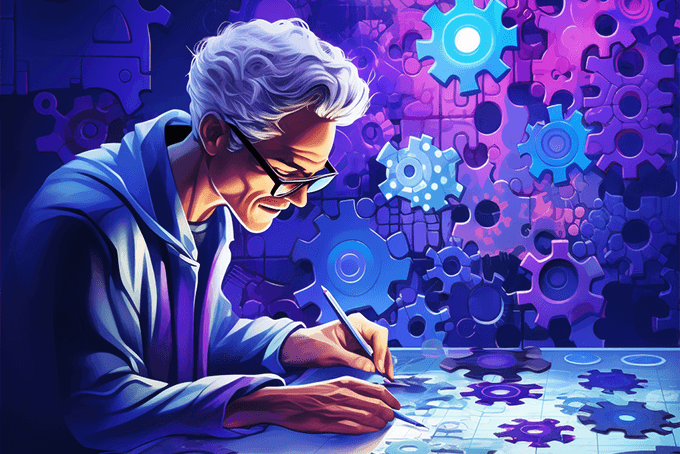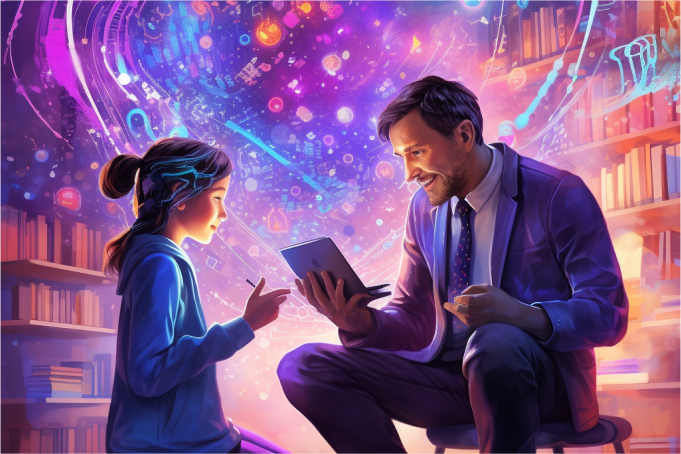Artificial intelligence tools have become increasingly sophisticated and accessible in recent years. Students may be tempted to rely heavily on AI to complete assignments and boost grades. However, overdependence on AI can hinder meaningful learning and mastery if not utilized strategically. The key is incorporating AI thoughtfully under the guidance of educators to augment, not replace, core competency development. When scaffolded appropriately, AI can serve as an interactive tutor – providing personalized guidance on gaps without externalizing the cognitive load needed for students to progress skills and abilities themselves. Here is an overview of ethical AI tutoring.
Balancing AI Assistance with Skill Development
John was excited to start high school after some struggles with writing organized essays in middle school. Two weeks into 9th grade English class, a classmate told John about an artificial intelligence app that could generate entire essays just by entering a few keywords. Intrigued, John decided to test out the AI tool to compose an essay for his next homework assignment. When the essay earned top marks from his teacher, John was thrilled and continued using the tool to complete all future writing assignments that semester.
On the surface, John was excelling – straight A’s in English with little effort on his part. However, his teacher noticed a disconnect. During class discussions, John struggled to express original viewpoints or structure coherent arguments without relying on the pre-formulated wording provided by the AI tool. When it came time to write a major research paper at the end of the term, John hit a wall. Without the AI tool doing the heavy lifting, he found himself unable to effectively plan, organize research, or formulate an argumentative thesis statement on his own for the more complex writing assignment. John had to depend heavily on the AI tool to complete the research paper.
As English education scholar Dr. Amelia Callier explains based on her research, “Writing is a complex, iterative process requiring critical competencies like planning ideation, outlining draft structure, reviewing and revising work. Simply relying on AI algorithms denies students the opportunity to build, practice and advance these essential skills themselves.” Without regular opportunities to independently work through the writing process from start to finish, students like John miss out on developing vital competencies.
So what core skills was John failing to sufficiently build by depending solely on AI to complete his homework essays? According to Dr. Callier’s findings, students need consistent practice and scaffolding to develop competencies related to:
- Brainstorming ideas and research sources relevant to the writing prompt
- Structuring drafts with clear introduction, body paragraphs, and conclusion
- Crafting a compelling thesis statement and supporting it with evidence
- Organizing related information coherently into focused paragraphs
- Explaining concepts fully using students’ own words and analysis
- Connecting ideas logically with smooth transitions
- Revising initial drafts iteratively to sharpen arguments and enhance flow
- Applying instructor feedback between drafts to improve technical writing skills
Without working through these key steps of the writing process himself, John was unable to build the abilities needed to translate ideas into organized, persuasive essays – especially when faced with more complex writing tasks.
So how could John have leveraged AI responsibly with guidance from his teacher to balance developing writing skills independently while also getting helpful AI tutor support on gaps when needed? Here is an example scaffolding process:
- Pre-writing stage: John actively brainstorms ideas and curates sources for research based on the essay prompt before using any AI tools.
- Outline: John organizes his pre-writing ideation into a structured outline for the essay including a clear thesis statement, topic sentences for each body paragraph, and supporting evidence.
- Rough draft: John writes an initial draft independently referring to his outline for direction. He may consult his teacher selectively on sections he is struggling with as he drafts. John resists over-relying on AI suggestions during early drafts.
- Revise and refine: Based on instructor feedback, John works to improve his thesis statement, add better transitions between ideas, fix organizational issues in paragraphs, and clarify explanations. He may strategically use AI tools to analyze small sections of his draft one paragraph at a time if needed for improvement suggestions.
- Final draft: John completes his final essay submission utilizing his original ideas, analysis, and demonstrating improved technical writing skills after revisions. AI was used minimally only as an interactive tutor, not as a ghostwriter.
With this guided process focused on developing core competencies first before strategic integration of feedback tools, students like John can take ownership of improving their skills over time while also getting helpful AI tutoring. The AI provides personalized guidance on gaps in understanding without externalizing the cognitive load fully.
Balancing AI Tutoring: Navigating the Risks of Over-Reliance
Let’s explore another subject area in which over-dependence on AI tools can short-circuit mastery – mathematics. Emily was starting 9th grade algebra after scraping by in pre-algebra in middle school thanks to some extra tutoring help. While she had worked hard to memorize formulas and algorithms, Emily often froze up when presented with word problems and struggled to apply algebraic concepts to real world scenarios. Abstract symbols on a page she could handle, but translating those into contextual situations remained difficult.
When a friend showed Emily a new AI smart app that promised it could solve any math word problem in seconds, she was thrilled. For each homework assignment, Emily simply snapped a picture of the word problem text and fed it into the AI app, writing down the detailed step-by-step solutions it produced without actually working through the problems herself. Her grades improved with this approach, but Emily’s conceptual understanding did not advance significantly. Without struggled attempts, she remained unable to initiate setting up or structuring solving word problems independently without the AI tool.
As math professor Henry Park explains based on pedagogical studies, “Working through complex, contextual word problems is where deeper learning occurs for students. When over-reliant on AI solutions, students externalize the cognitive load and mental structuring required to meaningfully progress skills.” Instead of retaining the problem-solving process, the student’s role becomes simply replicating the output of the AI.
To develop confidence in applying algebraic concepts and formulas to real world scenarios, experts recommend students need to:
- Thoroughly analyze word problems themselves first before consulting AI, making note of where they are stuck
- Attempt working through steps they understand themselves before copying AI explanations
- Review AI tutor guidance carefully for full comprehension rather than quick answers
- Validate the AI’s process and repeat some steps manually for improved retention
- Summarize the overall problem solving approach taken to facilitate future application
With this more guided integration, students like Emily can continue to advance their skills in unraveling real world math problems while leveraging AI for supplemental support on gaps. The right balance provides scaffolding while keeping cognitive load within the student’s zone of proximal development.
For educators, striking an effective balance is crucial when incorporating AI technologies into the classroom. Rather than banning AI use outright or allowing unfettered access, Prof. Haji’s research recommends facilitating thoughtful usage based on core learning principles:
“AI should be positioned to augment human teaching, not replace it. Educators must maintain responsibility for scaffolding ethical student usage focused first on human knowledge and skills, with AI as an interactive tutor. Ongoing self-regulation is critical.”
Here are some evidence-based best practices for guidelines:
School-Wide Policies and Culture
- Have open class discussions about the appropriate role of AI in academics – explain the pros, cons, limitations, and ethical concerns transparently without accusing students. Establish shared norms around accountable AI use.
- Prioritize building students’ core competencies related to learning objectives manually first before introducing any AI practice tools. Ensure a strong foundation.
- Model and provide instructional resources demonstrating effective learning strategies tailored to your subject area.
Ongoing Student Monitoring
- Assign some homework assessments to be completed without any AI assistance to diagnostically evaluate true unaided abilities.
- Use AI tutoring support selectively only for students still struggling even after providing other scaffolds to build skills. Monitor its impact.
- Review initial student work submissions before approving integration of AI tools to confirm independent effort and comprehension.
- Check for overreliance on AI; if students show lack of mastery without heavy usage, provide remediation focused on fundamental skills development.
Integrity Guidelines
- Develop an honor code policy students must sign pledging to use AI tools appropriately as outlined in class. Make expectations clear.
- Require proper source citation of any AI used on assignments to reinforce academic integrity.
- Leverage plagiarism detection tools cautiously to spot check selected assignments if needed. Avoid adversarial mindset.
- Additionally, teachers can further promote responsible usage by intentionally planning curricula around judicious AI integration:
- Structure assignments so students learn core competencies independently first, then practice applying skills with AI support. Gradually withdraw scaffolding.
- Design sections of larger projects as “AI-free zones” to assess students’ abilities to demonstrate knowledge unaided.
- Ask students to identify potential biases, limitations or errors in AI-generated content through critical analysis assignments.
- Have students give peer feedback on how to improve AI output to deepen understanding.
- Host debates about the ethics of overreliance on AI to build media literacy skills.
According to education scholars, “Rather than banning AI in academics, schools must guide students to use it strategically as an interactive tutor—not as an easily-abused external brain.” With the proper systemic supports, cultural norms and individualized guidance, teachers can promote ethical AI usage that enhances human teaching by providing personalized supplementation. But core responsibility over knowledge acquisition remains with the student.
The ultimate goal is for students to reach a point of self-directed learning where they have internalized foundational competencies and can demonstrate unaided mastery, seeking occasional AI tutoring as warranted rather than depending heavily upon it long-term. Maintaining high academic standards while providing appropriate, empathy-driven scaffolds is crucial for nurturing lifelong learners equipped to think critically in an increasingly AI-powered world. With thoughtful implementation strategies, educators can successfully leverage AI technologies to provide interactive guidance while students retain ownership over progressing their abilities.



